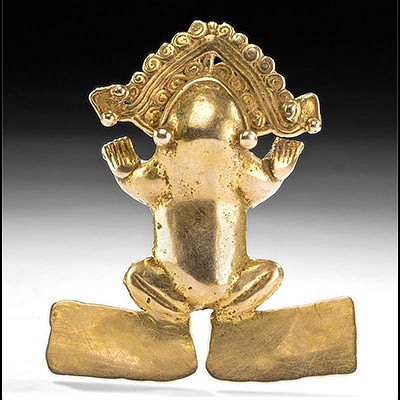Anatolian Marble Idol - Kusura Type
Lot 44d
About Seller
Artemis Gallery
686 S Taylor Ave, Ste 106
Louisville, CO 80027
United States
Selling antiquities, ancient and ethnographic art online since 1993, Artemis Gallery specializes in Classical Antiquities (Egyptian, Greek, Roman, Near Eastern), Asian, Pre-Columbian, African / Tribal / Oceanographic art. Our extensive inventory includes pottery, stone, metal, wood, glass and textil...Read more
Categories
Estimate:
$2,800 - $4,200
Absentee vs Live bid
Two ways to bid:
- Leave a max absentee bid and the platform will bid on your behalf up to your maximum bid during the live auction.
- Bid live during the auction and your bids will be submitted real-time to the auctioneer.
Bid Increments
| Price | Bid Increment |
|---|---|
| $0 | $25 |
| $300 | $50 |
| $1,000 | $100 |
| $2,000 | $250 |
| $5,000 | $500 |
| $10,000 | $1,000 |
| $20,000 | $2,500 |
| $50,000 | $5,000 |
| $100,000 | $10,000 |
| $200,000 | $20,000 |
About Auction
By Artemis Gallery
Aug 13, 2020
Set Reminder
2020-08-13 10:00:00
2020-08-13 10:00:00
America/New_York
Bidsquare
Bidsquare : Fine Antiquities, Ethnographic & Fine Art
https://www.bidsquare.com/auctions/artemis-gallery/fine-antiquities-ethnographic-fine-art-5415
Features classical antiquities, ancient and ethnographic art from cultures encompassing the globe. Egyptian, Greek, Roman, Etruscan, Near Eastern, Asian, Pre-Columbian, Native American, African / Tribal, Oceanic, Spanish Colonial, Russian, Fine Art, so much more! Artemis Gallery info@artemisgallery.com
Features classical antiquities, ancient and ethnographic art from cultures encompassing the globe. Egyptian, Greek, Roman, Etruscan, Near Eastern, Asian, Pre-Columbian, Native American, African / Tribal, Oceanic, Spanish Colonial, Russian, Fine Art, so much more! Artemis Gallery info@artemisgallery.com
- Lot Description
Ancient Near East, Anatolia, southeastern Turkey, Early Bronze Age II, ca. 2700 to 2300 BCE. A finely preserved idol figure of an extremely simplified anthropomorphic form, hand-carved from yellow-white marble with integral grey veining throughout. The Kusura-type idol is of a distinctly thin form with an ovoid body, a gently tapered neck, and a circular head devoid of any discernible facial features. Kusura idols come from the village of Kusura in modern-day southeastern Turkey. Votive idols like this one are known in a variety of fascinating forms throughout the pre-literate world. Their abstract nature suggests that, unlike modern artists, ancient sculptors did not have a penchant for conveying naturalistic human forms and could express themselves in more ambiguous yet profound ways. Size: 2.625" W x 5.1" H (6.7 cm x 13 cm); 5.7" H (14.5 cm) on included custom stand.
For a stylistically similar example, please see "Idols: The Beginning of Abstract Form." Ariadne Galleries, Inc., New York, 1989, p. 59, fig. 21.
Provenance: private East Coast, USA collection; ex-private Pappas collection, Massachusetts, USA, acquired in the 1980s; ex-private New York, USA collection, acquired in the 1970s; ex-Tepper Gallery auction, New York, USA, 1970s
All items legal to buy/sell under U.S. Statute covering cultural patrimony Code 2600, CHAPTER 14, and are guaranteed to be as described or your money back.
A Certificate of Authenticity will accompany all winning bids.
We ship worldwide and handle all shipping in-house for your convenience.
#152794Minor nicks and abrasions to obverse, verso, and peripheries, with light encrustations, otherwise intact and excellent. Light earthen deposits throughout.Condition
- Shipping Info
-
All shipping is handled in-house for your convenience. Your invoice from Artemis Gallery will include shipping calculation instructions. If in doubt, please inquire BEFORE bidding for estimated shipping costs for individual items.
-
- Buyer's Premium



 EUR
EUR CAD
CAD AUD
AUD GBP
GBP MXN
MXN HKD
HKD CNY
CNY MYR
MYR SEK
SEK SGD
SGD CHF
CHF THB
THB














